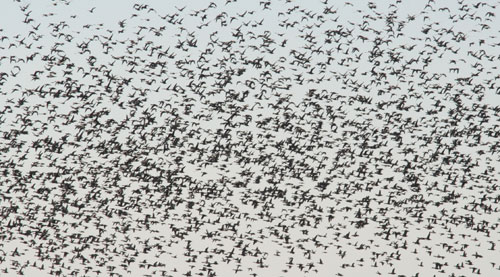
A recent survey by the U.S. Fish and Wildlife Service puts the breeding duck population at 49.2 million, surpassing the previous high set in 2012 and 8 percent ahead of the 2013 estimate. Robert Sloan photo
Waterfowl hunters got some very good news this week. North America’s spring duck population is at a record level, and the birds returned to find a high number of ponds on the breeding grounds, according to the 2014 Waterfowl Breeding Population and Habitat Survey released this week by the U.S. Fish and Wildlife Service.
Here’s a quick breakdown of duck numbers from the survey.
Breeding mallards (10.9 million) and gadwalls (3.81 million) are at the second-highest levels in the history of the survey. Green-winged teal (3.44 million) and blue-winged teal (8.54 million) came in at the third-highest tallies since 1955, while shovelers (5.28 million) and redheads (1.28 million) are at record-high breeding population levels.
Wigeon increased 18 percent to 3.11 million, while scaup added 11 percent to 4.6 million. Wigeon are now 20 percent above the long-term average, which is notable given concerns over a declining population trend in the 1990s and 2000s.
Unfortunately only pintails and canvasbacks declined. Pintails dropped by 3 percent to 3.22 million, while canvasbacks were down 13 percent, registering at 685,000.
The annual spring survey, which has been conducted jointly by the U.S. Fish and Wildlife Service and Canadian Wildlife Service since 1955, puts the breeding duck population at 49.2 million, surpassing the previous high set in 2012 and 8 percent ahead of the 2013 estimate.
In addition to record breeding duck numbers, more good news lies in continued wet conditions. Most of the Prairie Pothole Region, which encompasses much of Alberta, Saskatchewan, Manitoba, the Dakotas and Eastern Montana, is very wet. The May pond count, which registered a soaking-wet 7.18 million, is 40 percent above the long-term average. Better still, many prime duck production areas are even wetter today than when the survey was conducted. That’s unusual. Most years, temporary seasonal wetlands begin drying out by June. The one notable dry spot was eastern South Dakota.
“Exceptional water this year will lead to high duck production,” said Dr. Frank Rohwer, president of Delta Waterfowl. “When the prairies are really wet, ducks settle in the best quality habitat. Hens will nest and renest vigorously, and duckling survival will be high.”
Strong breeding duck numbers and very good water conditions should translate to more ducks in the fall flight, but it’s still not a guarantee of more birds over every duck hunter’s decoys this season. Local conditions during duck season always have a huge impact on hunting success.
“We know that when breeding duck numbers are high and duck production is strong, hunters shoot more ducks,” Rohwer said. “However, three other factors are probably as important as the breeding duck count. Weather is most critical, because that drives duck migrations. The site conditions such as food and available water at your honey hole impacts hunting success, as does the amount of hunting pressure.”
Still, considering the high duck counts and excellent water, the many millions of ducks will be out there this season, somewhere in North America.
“Rejoice in the great breeding pair counts,” Rohwer said. “Better yet, rejoice in the good May pond counts and continued good water conditions. Duck production is likely going to be off the charts. But don’t count your ducks in the bag until the weather and conditions bring you impressive flights.”
Spanish mackerel show up in numbers along the Port O’Connor jetties. Last week fishermen looking for reds and trout along the Port O’Connor jetties were surprised to find that big time numbers of Spanish mackerel had taken over along the rocks.
Mackerel, are fun to catch, but have razor sharp teeth and snip lines faster than greased lightning. One way to keep your lure and catch lots of these hard fighting fish is to rig up with a short 6-inch wire leader. Top lures are small silver spoons and soft plastic jigs in white, yellow or red.
Capt. Robert Sloan runs jetty, bay and surf fishing charters for reds, trout, tarpon and sharks. For details call 409 782 6796, email – sloan288@aol.com or check out www.hightailangler.com.
